Cite this document
(“Critically evaluate the view that Changing Organisational Culture is Essay”, n.d.)
Retrieved from https://studentshare.org/miscellaneous/1588514-critically-evaluate-the-view-that-changing-organisational-culture-is-difficult-if-not-impossible-and-requires-a-different-approach-to-other-types-of-change-initiatives
Retrieved from https://studentshare.org/miscellaneous/1588514-critically-evaluate-the-view-that-changing-organisational-culture-is-difficult-if-not-impossible-and-requires-a-different-approach-to-other-types-of-change-initiatives
(Critically Evaluate the View That Changing Organisational Culture Is Essay)
https://studentshare.org/miscellaneous/1588514-critically-evaluate-the-view-that-changing-organisational-culture-is-difficult-if-not-impossible-and-requires-a-different-approach-to-other-types-of-change-initiatives.
https://studentshare.org/miscellaneous/1588514-critically-evaluate-the-view-that-changing-organisational-culture-is-difficult-if-not-impossible-and-requires-a-different-approach-to-other-types-of-change-initiatives.
“Critically Evaluate the View That Changing Organisational Culture Is Essay”, n.d. https://studentshare.org/miscellaneous/1588514-critically-evaluate-the-view-that-changing-organisational-culture-is-difficult-if-not-impossible-and-requires-a-different-approach-to-other-types-of-change-initiatives.


